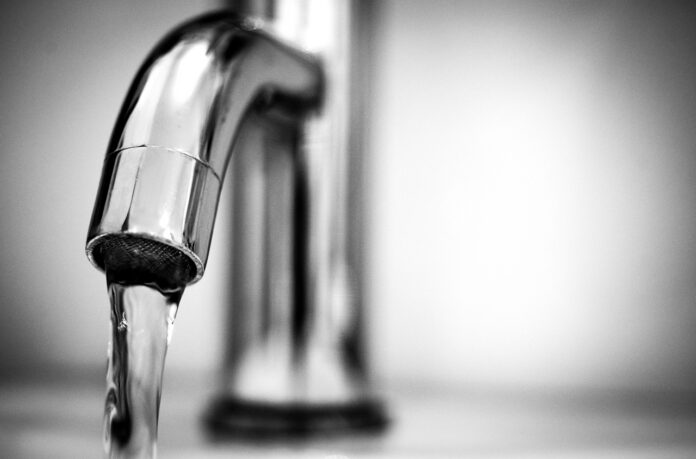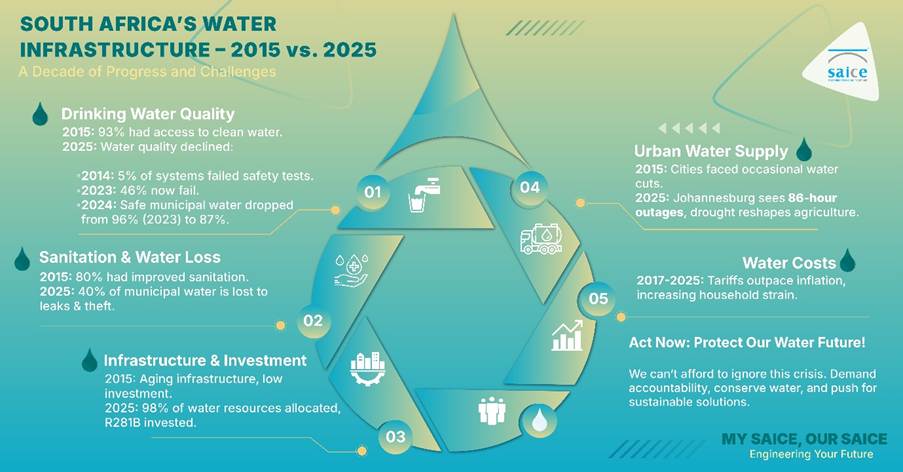
- South Africa's water infrastructure is getting worse, and the Ministry of Water and Sanitation estimates that over R90 billion a year will need to be spent over the next decade to repair and upgrade existing infrastructure, a clear indicator of the scale of the issue.
- The Saice Water Division commented, “more than 40% of the proportion of water produced and supplied to over 80% of the country is lost due to inadequate infrastructure maintenance, resulting in high non-repeated water (NRW) due to commercial losses such as leaks, lack of meters and theft.”
- Recognizing the urgency of the situation, the government has set aside R2.3 billion for seven large-scale water infrastructure projects, but Saice water experts say this is nothing more than a decline in the ocean because of what is really needed to stop the South African water crisis.
sAfrica is at a critical time in infrastructure development where water infrastructure is at the forefront of this challenge. Water safety is the foundation of economic stability and growth. Without reliable access to clean and affordable water, industry will decline, agriculture will suffer, community struggles, investors will rethink their investment in South Africa. From Nelson Mandela Bay and Komani in the Eastern Cape to the unfolding water shortages in Johannesburg, Johannesburg, Garten, millions of South Africans tackle dry taps, unreliable supply and degraded infrastructure.
For millions of people in poverty, unreliable access to clean water is not just an inconvenience. It poses a daily threat to health, livelihood and survival, not to mention revoking the constitutional human rights to water, as enforced as South Africa's fundamental human rights (supported by both the Constitution of 1996 and the Water Services Act 108 of 1997). Water instability can have ripple effects, slow the economy, disrupt education, worsen food shortages and undermine the overall stability of the country.
A recent 2025 budget speech shows that despite R15.63 billion commitment to water and sanitation, water engineering experts at the Institute of Civil Engineering in South Africa (SAICE) justify the lack of engineering experts to help municipalities use these grants efficiently.
With the famous World Water Day on March 22, 2025, the South African Water Moon appeared, making it a strong reminder of the harsh reality that South Africa is a water sculpture country and relies on about half of the global average rainfall to replenish surface water sources.
So, what is the cost of omission in South Africa regarding water security?
The country's water infrastructure crisis is exacerbated by rapid population growth and urbanization, climate change, inefficient water management, inadequately maintained infrastructure, and the unequal distribution of water resources. Insufficient investment in water infrastructure, particularly lack of funding for operations and maintenance – has emerged as an even greater challenge with increasing scarcity of water resources. Resolving them is not just an environment need, it is an economic order. In fact, without proper water security, our economy is contracted.
A recent 2025 budget speech shows that despite R15.63 billion commitment to water and sanitation, water engineering experts at the Institute of Civil Engineering in South Africa (SAICE) justify the lack of engineering experts to help municipalities use these grants efficiently.

“In the absence of proper planning, feasibility studies and appropriate technically driven procurement, such grants may be incorrect or even unavailable, whether upgrades, updates, or new infrastructure.”
The Saice Water Division recognizes positive advances made by the Ministry of Water and Sanitation (DWS) in recent years. In his budget speech on July 16, 2024, Honor, DWS Deputy Minister David Mahbo, stressed that almost R98 billion was spent by the sector to support local governments in infrastructure development across 144 water service authorities. This important commitment to improving water infrastructure is encouraging, and Saice fully supports these efforts.
However, despite some encouraging developments, Saice warns that there are still serious challenges that need to be overcome. Between 2018 and 2022, DWS spending hovered between R17 billion for all water programs, including new projects and maintenance. In contrast, the budget for the 2025-2025 period, totalling 2023-2025, failed to earn dents below the required target.
“We don't overemphasize essentials for fixing and updating aging and defective infrastructure. Statistics on non-revenue water have been lost in over 40% of the water produced and supplied to over 80% of the country, which were lost because of aging and broken infrastructure, as they were lost because of aging and broken infrastructure.
Environmentally, dysfunctional wastewater treatment plants have played an important role in untreated or partially treated sewage that is discharged into environments, including rivers and oceans. Lack of compliance and monitoring by competent authorities exacerbates the water crisis. During minor floods, the effects of degraded water flows on rivers are enormous, with wastewater treatment plants stimulating excessive lead growth and altering riverbeds. As a result, there is a possibility of 1:50 or 1:100 years of flooding, and developments in areas that were previously far from the flood zones have fallen within these flood zones, increasing the risk of flooding.
“This is harmful to the environment as it pollutes waterways that abstract drinking water, increases the complexity and cost of cleaning, pollutes the ocean and is dangerous to our health and seafood.
With a focus on spatial planning and development, the increased demand for inner city accommodation as a result of people's migration to urban areas requires planning of human settlements in the right areas. Engineers must be involved in or at least contribute to these developments. In the face of increased demand due to the growing urban population, many local governments do not deny the impact of failure to maintain and strengthen their infrastructure.
“In this situation, it is necessary to use the project cycle to successfully recover aged or collapsed infrastructure, to ensure that the system is properly planned and the system can be used to ensure it works properly.
“The scope of the government should encourage appropriately qualified, professionally registered personnel to be appointed with a reputable track record or to appoint a panel of experts.
Public-Private Partnerships (PPPs) may bridge the skills gap, but initial project preparation, namely feasibility studies and PPP procurement processes, are properly carried out by the local government and have expert support when necessary. PPPS holds a commitment to leverage government funds by focusing on project finance for bankable projects. Additionally, the PPP Unit and GTAC provide free advisory support for such initiatives, while the DBSA and ISA show their willingness to support qualified personnel and seed capital and project preparation.
Public-Private Partnerships (PPPs) may bridge the skills gap, but initial project preparation, namely feasibility studies and PPP procurement processes, are properly carried out by the local government and have expert support when necessary.
Once the PPP is concluded, the procurement state entities have efficient construction and robust contracts and budget guarantees to maintain the facilities for at least 20 years. However, costs must be covered through customs duties and should be considered appropriately during feasibility.
Dreyer said, “Saice has a wide range of learning programs aimed at metro and local government upskilling engineers who are willing to accept short-term assignments to add capabilities to these initiatives. Many of these programs are accessible online and through self-organization.”
Kelefetswe shares: “There is a deliberate intention to encourage the public sector to support the government to ensure that the planning programme will bear fruit. The process includes PPP, but can be jointly responsible and supplemented as a joint import project between the private and public sectors. That extends to local government preparation.”
“We recommend working towards different PPPs in a collaborative way, allowing parties to save time and money through signed agreements. Secondly, the funds allocated to projects in most systems, along with other costs, go to collaboration setups, but the full cost is spent on projects like RAND to optimize RAND contracts. Ethics and accountability as a key cornerstone,” advises Kelefetswe.
“The best solution should be to keep at a system level by reducing the amount lost or stolen. This is the only way the fund would do what it originally intended,” adds Kelefetswe.
Looking forward to it, leadership must be informed and affected by both national and local government levels, and appropriate decisions must be made regarding water resource management and development policies, budgeting and priorities.
For more information, please visit https://saice.org.za

